Magellanic Clouds in X-Ray
Large Magellanic Cloud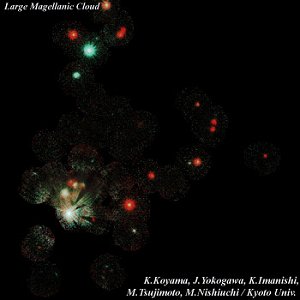 |
Small Magellanic Cloud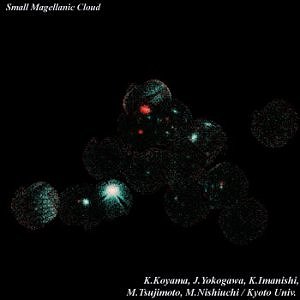 |
|---|---|
|
This is an X-ray color image of Magellanic Clouds observed by ASCA.
Due to the difference in the "color" of X-rays,
it was developed the method, which classifies the kind of X-ray sources clearly.
In the image, the color expresses the difference in the energy of X-rays; higher energy (2-7keV) is expressed by blue and lower energy (0.7-2keV) by red. Among bright objects, blue ones are X-ray pulsars and red ones are supernova remnants. It turned out that Large Magellanic Cloud have many supernova remnants and Small Magellanic Cloud have many X-ray pulsars. The region in Large Magellanic Cloud, which seems to have mixed red and blue, is a pulsar in a supernova remnant, or a black hole. The black region is the one not observed by ASCA yet. あすか で実施した,マゼラン雲のX線カラー撮影によって, X線の「色」の違いから, X線天体の種族をはっきり区別,分類する方法が発見されました. 上図は あすか が撮影した,大・小マゼラン雲のX線カラー写真です. 色はX線のエネルギーの違いを表しており,エネルギーが高い方(2-7keV)を青, エネルギーが低い方(0.7-2keV)を赤で表わしています. 明るい天体のうち,青いものはX線連星パルサー, 赤いものは超新星残骸です. 大マゼラン雲には超新星残骸が多く, 小マゼラン雲にはX線連星パルサーが多いことがわかります. 大マゼランに見える,赤と青が混ざったように見えている部分は, 超新星残骸中のパルサー,またはブラックホールです. 上の図で真っ暗な部分は,まだ あすか が観測していないところです.
なお,X線望遠鏡XRTの結像性能のために,
X線源が点源の場合も像が広がってしまい,
まるで蝶が羽を広げたような形に見えます.
明るい点源ではこの収差がとくに目立ちます. By courtesy of K.Koyama, J.Yokokawa, K.Imanishi, M.Tsujimoto, M.Nishiuchi (Kyoto Univ.) |
|
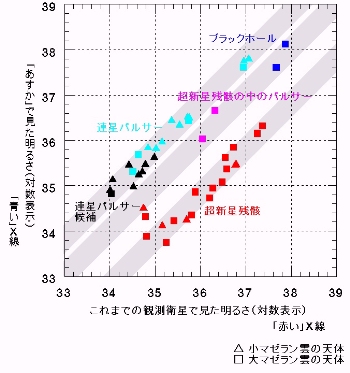 |
A left figure is a classification of objects in Magellanic Clouds by the "color" of X-rays.
In general the brightness of X-ray sources depends on its "colors".
Supernova remnants are bright in the red where the wavelength of X-rays is longer, while pulsars are bright in the blue where the wavelength of X-rays is shorter.
A lower figure is a comparison of the number of each objects. Since the mass of Magellanic Clouds are 1/10 and 1/100 of our galaxy, respectively, the numbers are rescaled considering the mass ratio. As a result, it turned out that it is surprisingly so high that the distribution density of X-ray pulsars and supernova remnants in Magellanic Clouds, compared with our galaxy. |
|---|---|
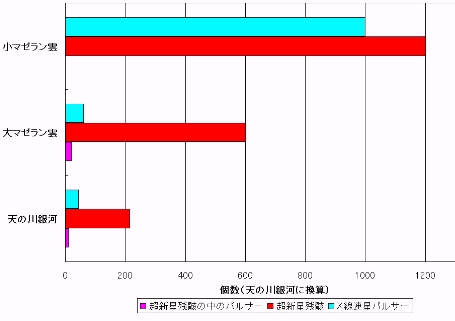 |
|
|
左の図は,X線の「色」による,マゼラン銀河の天体の分類です.
一般にX線天体は,その「色」によって明るさが違います.
超新星残骸は(波長の長い)「赤い」X線で明るく,
連星パルサーは(波長の短い)「青い」X線で明るく見えることから,
X線天体の分類ができます.
下の図は,各種天体の個数の比較です. 大小マゼラン雲の質量は,銀河系の10分の1,100分の1であるため, われわれの銀河系(天の川銀河)と同じ質量に換算して比較するため, 大マゼラン雲の天体の個数は10倍, 小マゼラン雲のそれは100倍にしてあります. その結果,マゼラン雲では天の川銀河に比べ, X線連星パルサーと超新星残骸の分布密度が驚くほど高いことがわかりました. とりわけ小マゼラン雲におけるX線連星パルサーで際立っています.
小マゼラン雲で1997年までに知られていたX線連星パルサーは3個でしたが,
1998年になって,あすか などにより,
新たに7個のX線天体から脈動(つまりパルサー)が発見されました.
さらに先述の分類法を適用し,
20個近くのX線連星パルサーとその候補天体が見つかったのです.
約100倍も巨大な天の川銀河ですら,これまでの30年間で約60個ですから,
小マゼラン雲は今まさにパルサーラッシュといえます. 近接する大小マゼラン雲と天の川銀河は, 互いの強い重力場の中で複雑に動き回っています. 遠い過去にはニアミスもあったことと思われます. そんなときには,小柄な小マゼラン雲は深刻な影響を受けます. 隣にある銀河(天の川銀河)の強い重力は小マゼラン雲のガスを激しく擾乱・圧縮し, それが1000万年ぐらい昔のスターバーストの引き金になったのでしょう. X線カラーイメージは, 隣の大きな銀河に翻弄される小マゼラン雲の数奇な運命を映したスナップショットと言えるようです. By courtesy of K.Koyama, J.Yokokawa, K.Imanishi, M.Tsujimoto, M.Nishiuchi (Kyoto Univ.) | |
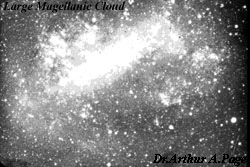
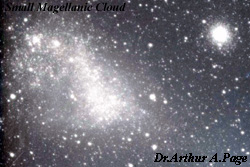
 Go to Submenu
Go to Submenu Go to Menu
Go to Menu